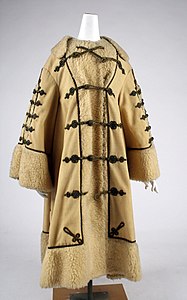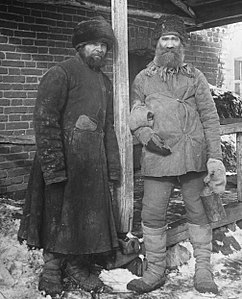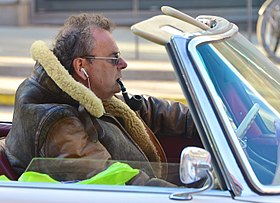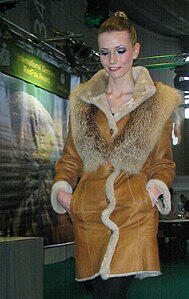Bare fur
Naked fur , also “as if grown” , also called Bunda , especially in designs based on the Eastern European costume style , are outdated names for a fur for men or women that is to be worn with the leather side facing outwards , without an overlying fabric cover. In a study of skinning in Frankenberg, Saxony, from 1895, the descriptive term leather fur is used instead of nude fur .
As a rule, naked furs were made from sheepskin , more rarely from goatskin . Thanks to modern options for the finishing of the leather side, furs from more noble types of fur can now also be produced with the leather on the outside. Naked furs are now differentiated according to the type of leather treatment as velor lamb jackets, nappa lamb coats and according to the type of fur, as velvet or napped rabbit coats , mink coats , etc.
history
Until the time after the Second World War (1939–1945), fur coats and jackets were largely timeless, they followed fashion only to a small extent. In the provinces in particular, the furriers have always tried to suppress any innovation, if only to hinder foreign competition. That was also true, perhaps especially, of the easy-to-work bare furs. In 1607, for example, in Silesia the residents of Wohlau quarreled with the Liegnitz furriers. The colleagues from Liegnitz had offered newfangled peasant furs that were open on the armpit, and they were also sold well. The fine of 6 thalers imposed by the city council at the instigation of the Wohlau guild had to be withdrawn after a decision by the ducal government. There were also disputes about the supposedly inadmissible decoration of the furs, which the local furriers probably could not produce. The master associations, especially in small towns, used regional restrictions again and again to have foreign fair feeders also forbid the sale of such “new fashions” that are “not in use” as far as possible. While the "coarse furriers" of the smaller towns mainly worked lamb and sheepskins for the surrounding rural population, the "fine furriers" of the large cities produced fur linings and trimmings from mostly imported, more valuable types of fur .
A fur seamstress, a specialist author of the GDR, wrote about the use of bare fur made from rabbit fur or lambskin in 1958, stating that most of them were intended for seafarers, shipyard workers and border police officers. The buyers of the fur vests included coal and mine workers, drivers, security guards and people who had to spend most of the winter outdoors or in unheated rooms. These pieces were almost exclusively protective work clothing, in which the external beauty was only second to the general assessment of a piece of clothing. The warming properties, comfort and durability were of primary importance. Of course, they should look neat, sleek, and clean, but in any case, functionality was paramount.
Around the 1960s and 1970s, fur fashion began to orientate itself directly on textile fashion. The furs that were worn with the leather on the outside now also took part in the fashion developments, at the same time the already less used term nude fur finally disappeared from common parlance.
The "fur lexicon" from 1950 actually no longer describes naked fur, but rather the fur lining , which has been popular since the Middle Ages , only now with a synthetic fabric cover instead of natural materials: "The most modern cut naked furs are also covered with nylon on the leather side ".
Bunda (costume)
Bunda, also Schuba , is in the narrower sense of the word the name of a lamb or sheepskin, which is often wide, reaching to the ground and worn with the leather side facing outwards. The name "Bunda" is relatively new, it appears for the first time in 1723, it comes from the German word "bunt" in the sense of Buntwerk = fur. In general, all similarly crafted, often richly embroidered, Eastern European naked furs were called Bunda.
Nude fur, Bunda (supraregional)
Carriage drivers and passengers wore warm bare-bones , and when it was mentioned in 1930, the users of the still unheated automobiles also wore them. For this purpose, in addition to their use for footmuffs and fur blankets , the skins of so-called country or peasant sheep were mainly used: The sheep were called Pomeranian, Holstein, Bavarian or Greek sheep after their homeland, or as Heidschnucke , Rhön sheep , etc. One was preferred Variation of the racket sheep and similar breeds of southern Europe, whose skins were in trade under names such as "Transylvanians", "Corsicans", "Triester", "Turin", "Macedonians" and "Turks".
A special form of naked fur was the zippel fur (→ main article Zippel fur ). Zippelfurz or Zipfelfurz refers to a former peasant winter coat made of lambskin or goatskin with an elongated hem at the front and back in the manner of tails. The term zippel fur and its shape with the two skirt tails was mainly found in Eastern Germany (Upper Lusatia, Silesia) and Eastern Europe.
As functional clothing, bare furs played a special role alongside fur-lined clothing in both world wars. Initially lamb or sheep fur vests were made later came awake furs , pilots furs and other military uses it.
After the Second World War, some companies began to produce mainly women's furs for which the leather was dyed brown, green or other colors. The ironing of the hair introduced by the Liftschütz & Zickerow company brought about a significant improvement in the appearance of the hair side, which is usually visible on the collar and cuffs, and possibly also as a cover on the front edge. Another major advance was the fixation of the fur, which permanently prevents the hair from curling up again. The inventor was the Hungarian Fogl, who sold his patent to the important lambskin trading company Pannonia in Budapest before the Second World War . The refining process, which is expensive compared to the fur value because it is complex, is still used in principle, but has been continuously improved. Since then, sheepskins have also been used for trimmings on ready-made fabrics and for jackets and coats that are to be worn with the hair on the outside under the general name “ beaver lamb ” or the “merino lamb ”, which is less prone to frizz .
Manufacture (1891)
In one of the first specialist books for furriers from 1891, the production of naked furs was described:
“A special type of manufacture is the production of so-called naked furs, which are made from white and black sheepskins for use by country people in several regions with a very cold climate. These are furs without a fabric cover. To do this, the skins are straightened with an iron and peeled off particularly clean and white, and prepared and selected as carefully as possible so that there are no holes in them. The latter must be covered with small, round-cut pieces of leather that are neatly needled . The furs have to be cut so that the fur no longer needs to be stretched out and shows as few seams as possible. For this purpose, the pelts are not cut out, but the skin is first leveled, the pelts are then sheared into a regular façon and a piece of the waste of the skin is peened on it , that is, a suitably cut piece of the hair is sewn onto it in such a way that it is needled all around, but only pierced halfway through the leather, so that nothing can be seen in the latter. The pieces on the head, as well as the fur seams are then sewn in and together from the hair, with front stitches, often with the insertion of a strip of leather or leather passepoil , in order to make this seam as invisible as possible. The edges all around are then trimmed with leather (usually cut from a bald hide) so that nothing is warped, furthermore a hanger made of twisted or three strips of braided leather is attached, as well as buttons and eyelets made of leather, whereby a lot of artistry is often shown. "
The lower-quality sheepskin sorts were mostly sold to Russia, Hungary, etc. for cheap peasant fur at the time.
See also
Web links
Individual evidence
- ^ Albin König: The furrier in Frankenberg in Saxony . In: Studies on the situation of the craft in Germany with special consideration of its competitiveness compared to large-scale industry . Volume 2, Kingdom of Saxony , first part, Duncker & Humblot, Leipzig 1895, p. 321.
- ^ Fritz Wiggert: Origin and development of the old Silesian furrier trade with special consideration of the furrier guilds in Breslau and Neumarkt . Breslauer Kürschnerinnung (Ed.), 1926, pp. 113–115, 276 ( → book cover and table of contents ).
- ↑ Eva Laue: The interior finishing . In: Das Pelzgewerbe No. 1, 1959, pp. 35-36.
- ↑ a b c Alexander Tuma: Pelz-Lexikon. Fur and Rauhwarenkunde, Volume XX . Alexander Tuma, Vienna 1950, p. 24 Keyword “naked furs” .
- ^ Hermann Deutsch: The modern skinning. Manual for the furrier, dyer, bleacher, cutter and garment maker . A. Hartleben`s Verlag, Vienna / Leipzig, 1930. P. 89.
- ^ H. Werner: The furrier art. Publishing house Bernh. Friedr. Voigt, Leipzig 1914, p. 105.
- ↑ Paul Schöps: lambskins and sheepskins. In: The fur trade. 1957, No. 4, Volume VIII / New Series. Hermelin-Verlag, Leipzig / Berlin / Frankfurt am Main 1957, p. 132.
- ↑ P. Spahl: Beaver lamb and its refinement. In: The fur industry. Issue 2, Berlin, February 1964, pp. 26-29.









